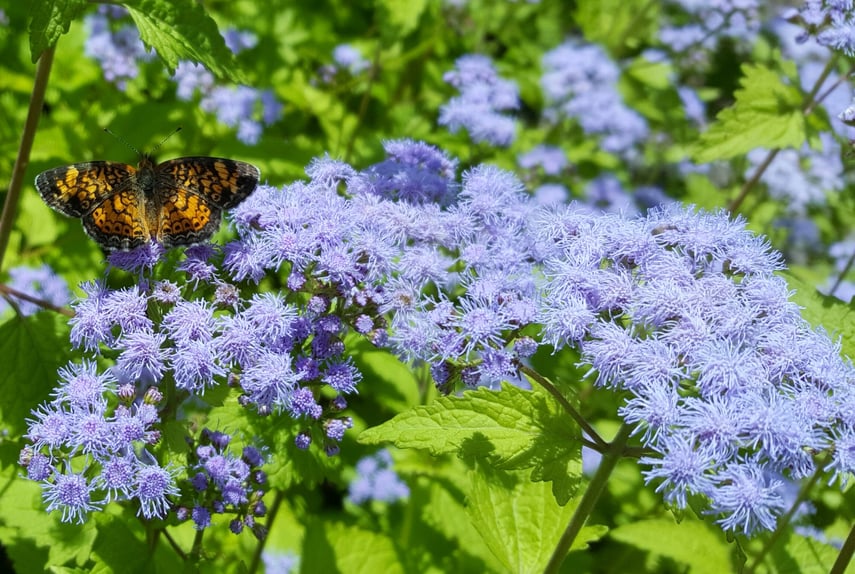Rain gardens are a natural way to manage stormwater run-off, and they play an important role in delivering ecosystem services through the landscape. Rain gardens absorb water and allow it to percolate rather than running off into storm drains. They filter contaminants by removing sedimentation and debris, therefore improving water quality. Also, the plants selected for a rain garden can boost its value as an environmental asset by attracting pollinators, butterflies and birds.
When choosing plants for a rain garden, it is critical to consider the soil conditions throughout the space. The low-lying areas of the rain garden will retain the most moisture, while upper sections of the garden might dry out rather quickly after rainfall. So, you’ll want to include a variety of trees, shrubs, flowers and grasses that can adapt to varying soil moisture levels.
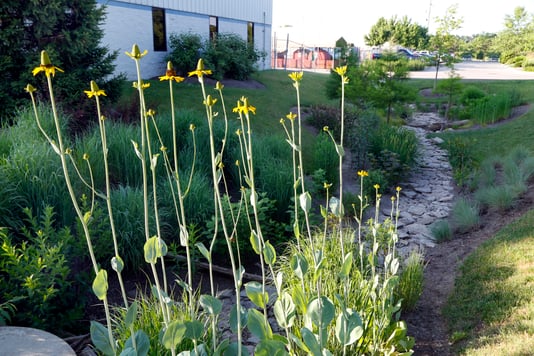
Also, you’ll want to consider how plants are layered to create a foreground, mid-ground and background that is functional and aesthetically pleasing. Select plants with bloom times ranging across all the seasons so the rain garden will always have color, and remember that foliage and grasses are another way to introduce varying hues.
By planting a range of grasses, perennials, shrubs and trees, you’ll gradually attract a diversity of wildlife to the rain garden that take advantage of those habitats.
Following are 15 plants that thrive in Kentucky rain gardens.
Best Trees for a Kentucky Rain Garden
Bald Cypress
The Bald Cypress thrives in saturated soil, and it’s a tree that is often found in southern swampland. This specimen tree can be a stunning visual anchor in the rain garden because of its interesting bark texture and the small, soft green leaves it produces. As the Bald Cypress matures, its roots push up “knees”—essentially roots are coming up out of the ground for air.
Black Tupelo
Black Tupelo’s star season is fall, and it’s known for a vibrant show of color —red, orange, bright red and purple. The medium-sized native tree is a standout with textured bark. Bees are attracted to the Black Tupelo, so it not only performs well in saturated soil, but also provides this additional ecosystem service. As for its success in rain garden soil, consider the name Tupelo, which is Muscogee for “tree” and “swamp.” The tree is also commonly referred to as a black gum tree.
River Birch
The River Birch loves moist soil, and its cinnamon-colored bark curls, creating textural interest in the landscape. The River Birch will grow quite large, and fast, reaching over 40 feet tall. Its round canopy provides shade. River birch tends to have fewer disease problems than other types of birch trees, and it can withstand the saturated soil in rain garden and some drought conditions, too.
American Sycamore
You’ll often find Sycamore trees along creek sides and river banks because this fast-growing tree loves swampy environments and does well in over-saturated soil, which is what you’ll find in rain gardens when they’re hard at work filtering water. What we love about the Sycamore is its ability to tolerate pollution from the environment, so it can thrive in urban rain garden settings without getting overly stressed from vehicle exhaust and other air quality factors. The Sycamore produces large leaves and bark in white, cream and green that flakes away from the trunk to expose the bark underneath. (The bark does not stretch and grow with the tree, so it exfoliates layers.) You’ll get constant interest and a dependable, hardy tree with a Sycamore.
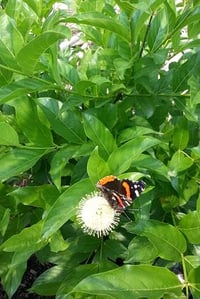
Best Shrubs for a Kentucky Rain Garden
Button Bush
The Button Bush attracts pollinators and butterflies, and the mid-summer bloomer can handle the moisture in rain garden soil. It will even thrive in standing water. The button bush forms flower heads that are globe-shaped fruits with needle-like styles that project from the sphere. The blooms look like fancy little ornaments hanging on the rounded shrub, with its glossy green leaves.
St. John’s Wort
St. John’s Wort is available in a number of different varieties that will perform well in a Kentucky rain garden. The bushy St. John’s Wort (Hypericum densiflorum), which is native to low boggy areas, produces a show of bright-yellow blooms, along with red fruits that also provide visual interest. You can find several different species of St. John’s Worts that work well in rain gardens, but a few require dry soil so choose accordingly.
Ninebark
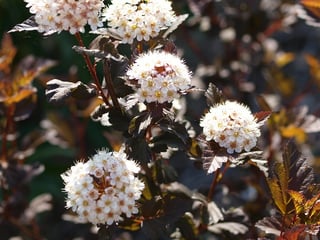
The deep, purplish foliage of the Ninebark make it an attractive shrub for the rain garden. It produces bunches of tiny, compact cream blooms, offering an attractive color contrast. There are several different varieties of Ninebark that thrive around the top edges of the rain garden environment. One we like is Little Devil Ninebark, a dwarf variety that is compact and grows just 2 to 3 feet. Also popular is the Diabolo Ninebark.
Best Perennial Flowers for a Kentucky Rain Garden
Siberian Iris
While there are many native Iris that work perfectly well in rain gardens, Caesar’s Brother Iris is larger growing with striking deep purple flowers. Known commonly as Siberian Iris, it is a variety that loves moist soil. It stands tall, with flower stalks growing up to 4 feet high, so they layer well with shrubs and other lower-growing plants in the landscape.
Penstemon
The Penstemon has small, white bell-shaped flowers that grow on a stalk and purple leaves that provides an attractive contrast to other green-bearing plants in the landscape. This versatile native is best planted toward the top of a rain garden basin, where soil tends to drain more readily.
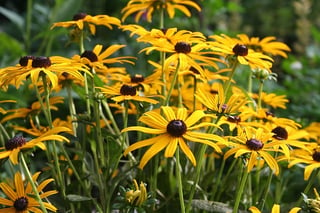 Black-Eyed Susan
Black-Eyed Susan
The Rudbeckia coneflower is a hardy perennial with daisy flowers that attract pollinators and birds. Their flowers produce a seed head that finches love. Rudbeckia is available in a yellow and orange hues, delivering a shot of sunny color to your Kentucky rain garden. Like Penstemmon, this perennial performs best in the faster-draining areas of your rain garden. (Iris, on the other hand, will thrive in the base of the rain garden, where soil retain the most moisture.)
Milkweed
Milkweed is an important plant in any garden, including rain gardens, because of its ability to handle moist soil conditions and offer important ecosystem benefits, such as attracting butterflies and pollinators. For your Kentucky rain garden, opt for the common milkweed or swamp milkweed, which are especially adapted to wet soil. You’ll find their blooms in a range of colors—the swamp milkweed producing pink-to-mauve colored flowers that smell like chocolate to some people. This species will grow 3 to 4 feet tall.
Blue Mist
Commonly called bluebeard, the Blue Mist produces one of the truest blue perennial flowers available. It adds a shot of vibrant color to your rain garden with a generous bloom time, June to September. Blue Mist grows in a mound shape, making it an ideal border plant. It tolerates the soil conditions found in rain gardens.
Best Grasses for a Kentucky Rain Garden
.jpg?width=320&name=Andropogon_scoparius_(3903375875).jpg) Little Blue Stem
Little Blue Stem
This warm-season native prairie grass grows upright and reaches 2 to 3 feet, and is known for it characteristic bluish blades that turns bright rusty-orange in fall. Plant this grass in upper areas of the rain garden, where soil tends to dry out more quickly after rainfall.
Panicum
Commonly called switch grass, Panicum includes many varieties and is a taller grass that can reach 4 to 6 feet, especially when its flower stalks are in full bloom. Some varieties have blue foliage while others will turn bright red in fall, others yellow. The variation in color and texture that Panicum brings to the landscape make it an interesting textural backdrop for the rain garden.
Carex
Airy carex grass, known as sedge, grows in compact clumps and grow up 6 to 12 inches. Their solid green foliage handles moisture well and the wispy foliage offers a textural contrast to shrubs and perennials in a rain garden.
Conclusion
Installing a rain garden is just one way to ask more of your landscape by delivering important environmental benefits to your property, and the community. Let’s talk more about how a rain garden can be designed and build on your commercial Kentucky property and what benefits you can realize. Call us any time in Lexington at 859-254-0762 or Louisville at 502-264-0127. Or, fill out this simple contact form and we’ll get in touch with you.
